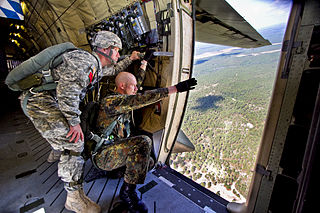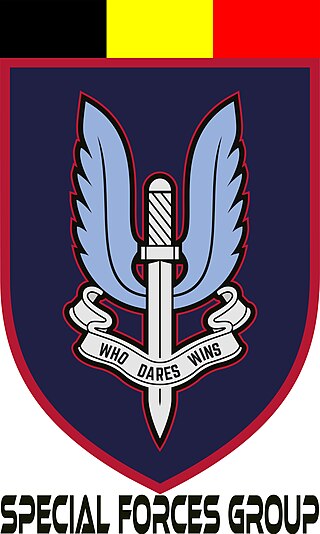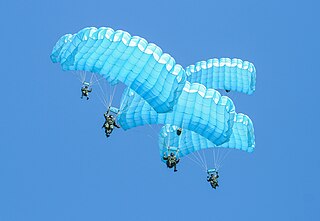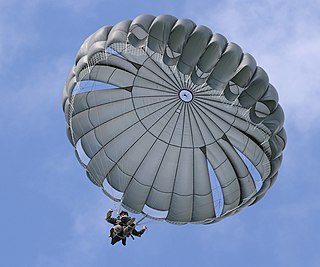
A parachute is a device used to slow the motion of an object through an atmosphere by creating drag or, in a ram-air parachute, aerodynamic lift. A major application is to support people, for recreation or as a safety device for aviators, who can exit from an aircraft at height and descend safely to earth.

High-altitude military parachuting, or military free fall (MFF), is a method of delivering military personnel, military equipment, and other military supplies from a transport aircraft at a high altitude via free-fall parachute insertion. Two techniques are used: HALO and HAHO.

Force Reconnaissance (FORECON) are United States Marine Corps deep reconnaissance companies that supply military intelligence to the command element of the Marine Air-Ground Task Force (MAGTF). Force Reconnaissance companies unlike USMC division reconnaissance report to the Marine expeditionary force (MEF) and provide direct action and deep reconnaissance during large-scale operations.

A parachutist badge is a military badge awarded by the armed forces of many states to soldiers who have received parachute training and completed the required number of jumps. It is difficult to assess which country was the first to introduce such an award.

The Military Freefall Parachutist Badge is a military badge of the United States Army and United States Air Force awarded to qualified U.S. Army and U.S. Air Force personnel as high-altitude military parachute specialists.

The Parachutist Badge, also commonly referred to as "Jump Wings", is a military badge of the United States Armed Forces. Some services, such as the Marine Corps, officially refer to it as an insignia instead of a badge. The United States Space Force and United States Coast Guard are the only branches that do not award the Parachutist Badge, but their members are authorized to receive the Parachutist Badges of other services in accordance with their prescribed requirements. The DoD military services are all awarded the same Military Parachutist Badge. The U.S. Army and U.S. Air Force issue the same Senior and Master Parachutist Badges while the U.S. Navy and U.S. Marine Corps issue the Navy and Marine Corps Parachutist Insignia to advanced parachutists. The majority of the services earn their Military Parachutist Badge through the U.S. Army Airborne School.

A parachute landing fall (PLF) is a safety technique that allows a parachutist to land safely and without injury. The technique is performed by paratroopers and recreational parachutists alike. The technique is used to displace the energy of the body contacting the earth at high speeds. The parachutist ideally lands facing the direction of travel with feet and knees together. At the moment first contact is made with the ground, the person goes from an upright position to absorbing the impact by allowing the body to buckle and go toward a horizontal position while rotating toward the side. When executed properly, this technique is capable of allowing a parachutist to survive uninjured during landing speeds that would otherwise cause severe injury or even death.

The United States Special Operations Command (USSOCOM) Parachute Team, called the Para-Commandos, is composed of volunteers from the United States Army, Navy, Air Force, Marines and U.S. government civilians who are assigned to Special Operations Command. They are selected for the team after a rigorous training program. They participate with the USSOCOM Parachute Team in addition to their regular duties, with training conducted during off duty time.

In skydiving, an automatic activation device (AAD) is a dead man's switch consisting of an electronic-pyrotechnic or mechanical device that automatically opens the main or reserve parachute container at a preset altitude or after a preset time.

A static line is a fixed cord attached to a large, stable object. It is used to open parachutes automatically for paratroopers and novice parachutists.

Tandem skydiving or tandem parachuting refers to a type of skydiving where a student skydiver is connected to an instructor via a harness. The instructor guides the student through the whole jump from exit through freefall, piloting the canopy, and landing. The student needs only minimal instruction before making a tandem jump with the instructor. In the United States most skydiving centers and clubs require that participants be 18 years or older to skydive whereas in other countries the minimum age can be lower or higher. This is one of three commonly used training methods for beginning skydivers; the others being Static line, Instructor-assisted deployment (IAD), and Accelerated freefall (AFF) (k).

Accelerated freefall (AFF) (known in Canada as progressive freefall, and in Finland as Nova (NOpeutettu VApaapudotus, a literal translation) is a method of training for skydiving, called accelerated because the progression is the fastest way to experience solo freefall, normally from 10,000 to 15,000 feet above ground level (AGL), allowing one to reach a higher terminal velocity than normal.

Leslie Leroy Irvin was a stunt-man for the fledgling Californian film industry. Flying in balloons, he performed using trapeze acrobatics and parachute descents. For the 1914 film Sky High, Irvin made his first jump out of an airplane while flying at 1,000 feet above the ground. In 1918, he developed his own life-saving static line parachute, jumping with it several times and promoting it to the US Army. Irvin joined the Army Air Service's parachute research team at McCook Field near Dayton, Ohio where he made the first premeditated free-fall jump with the modern parachute on April 28, 1919.

The United States Army Parachute Team, nicknamed the Golden Knights, is a demonstration and competition parachute team of the United States Army. It consists of demonstration and competition parachutist teams, drawn from all branches of the U.S. Army. Members must demonstrate excellence in parachuting.
RAPS or Ram Air Progression System is a parachuting training system designed to take a student from beginner to the FAI A License using square ram air canopies.

Jumpmasters are the expert paratroopers in an airborne unit who train and teach the military techniques for jumping from airplanes. They are responsible for training soldiers who enter Army Airborne School into paratroopers and managing airborne jump operations in airborne units across all branches of services.

The Special Forces Group is the special forces unit in the Land Component of the Belgian Armed Forces.

Parachuting and skydiving is a method of transiting from a high point in an atmosphere to the ground or ocean surface with the aid of gravity, involving the control of speed during the descent using a parachute or parachutes.
Parachute School of Toronto was a Canadian Sport Parachuting Association affiliated parachuting centre and skydiving drop zone operating from the Baldwin_Airport in Georgina,_Ontario.

The MC-6 Parachute is a Maneuverable Canopy(MC) static line-deployed personnel parachute of the United States Armed Forces. Developed by United States Army Special Forces, the parachute has been used by American Special Operations Forces (SOF) beginning in 2006 and Australian SOF starting in 2011.




















